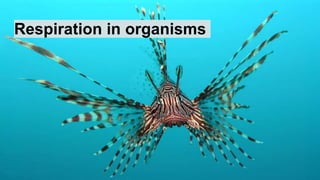
GRADE 7 CBSE CHAPTER 10 RESPIRATION IN ORGANISMS
- 2. Why do we respire? ● A cell is a structural and functional unit of living organisms. ● Cells performs functions like nutrition, transport, excretion etc for which it requires energy. ● The food has stored energy which it releases during respiration. ● During breathing we breathe in air which is rich in oxygen and breathe out air that is rich in carbon dioxide. ● The air we breathe is transported to all parts of the body and ultimately to each cell. ● In the cells, oxygen in the air helps in the breakdown of food. ● The process of breakdown of food in the cell with the release of energy is called cellular respiration
- 3. Aerobic Respiration ● In cells, the food (glucose) is broken down into carbon dioxide and water using oxygen. ● When the breakdown of glucose occurs with the use of oxygen it is called aerobic respiration.
- 4. Anaerobic Respiration ● Many organisms ( like yeast)can survive in the absence of air. They are called anaerobes. ● They get energy through anaerobic respiration. ● In the absence of oxygen glucose break down into alcohol and carbon dioxide. It is called anaerobic respiration
- 5. Anaerobic respiration in humans ● Muscles of humans also respire anaerobically, for a short period of time. ● During heavy exercise, cycling, walking for many hours etc, the demand for energy is high but the supply of oxygen produced is limited. ● Anaerobic respiration takes place in muscles to fulfil the demand of energy. ● Cramps occurs in muscles due to anaerobic respiration. Accumulation of lactic acid causes muscle cramps. ● Taking a hot water bath or massage improves circulation of blood, due to which supply of oxygen to muscle cells increases. ● This increase in the supply of oxygen results in the complete breakdown of lactic acid into carbondioxide and water.
- 8. Breathing ● Breathing is taking in air rich in oxygen and giving out air rich in carbon dioxide with the help of respiratory organs. ● The taking in of air rich in oxygen into the body is called inhalation and giving out air rich in carbon dioxide is known as exhalation. ● The number of times a person breathe in a minute is termed as the breathing rate. ● A breathe means one inhalation plus one exhalation. ● On an average, an adult human being at rest breathes in and out 15-18 times in a minute (After heavy exercise up to 25 times per minute)
- 9. Why do we yawn when we are sleepy or drowsy? ● One is that when we are bored or tired, we just don’t breathe as deeply as we usually do. ● Our bodies take in less oxygen because our breathing has slowed. ● Therefore, Yawning helps us bring more oxygen into the blood and move more carbon dioxide out of the blood.
- 10. How do we breathe? ● We breathe through our nostrils into our nasal cavity. ● From the nasal cavity, the air reaches our lungs through the wind pipe. ● Lungs are present in our chest cavity , which is surrounded by ribs on the sides. ● A large muscular sheet called diaphragm forms the floor of the chest cavity. ● Breathing involves the movement of the diaphragm and the rib cage.
- 12. ● During inhalation, the ribs move up and outward and diaphragm moves down. ● This movement increases space in our chest cavity and air rushes into the lungs. ● The lungs gets filled with air. ● During exhalation, ribs move down and inward, and the diaphragm moves up to its former position. ● This reduces the size of the chest cavity and the air is pushed out of the lungs.
- 13. Mechanism of breathing in human beings
- 16. ● From the nostrils the air passes into the nasal cavity and then goes down the windpipe or trachea. ● From here, the air goes through two smaller tubes called bronchi (singular bronchus), one of which enters each lungs. ● In lungs each bronchus divides and redivides into finer tubes called the bronchioles. ● Each bronchiole ends in a number of air sacs, called alveoli (singular alveolus) ● Alveoli have very thin walls and are supplied with blood capillaries.
- 17. Sneezing
- 18. Model to show mechanism of breathing
- 19. Effect of exhaled air on lime water (Calcium hydroxide)
- 20. Breathing in other animals Cockroach ● A Cockroach has small openings on the side of its body called spiracles. ● Insects have a network of air tubes called tracheae for exchange of gases. ● Oxygen rich air rushes through the spiracles into the tracheal tubes, diffusing into the body tissues, and reaches every cell of the body. ● Carbon dioxide from the cells goes into the tracheal tubes and moves out through spiracles. ● These air tubes are found only in insects and not in any other group of animals.
- 25. Earthworms ● Earthworms breathe through their skin ● The skin of the earthworm feels moist and slimy on touching. ● Gases can easily pass through them. Frogs Frogs have a pair of lungs like human beings, they can also breathe through their skin, which is moist and slippery.
- 28. Do plants also Respire? ● Plants respire. They take in oxygen and give out carbon dioxide. ● In cells oxygen is used to break down glucose into carbon dioxide and water. ● The leaves of plants have tiny pores called stomata for the exchange of oxygen and carbon dioxide. ● The root cells of plants also need oxygen to generate energy. ● Roots take up air from the air spaces present between the soil particles.
- 29. Roots absorb air from the soil
- 30. What happens if a potted plant is overwatered?